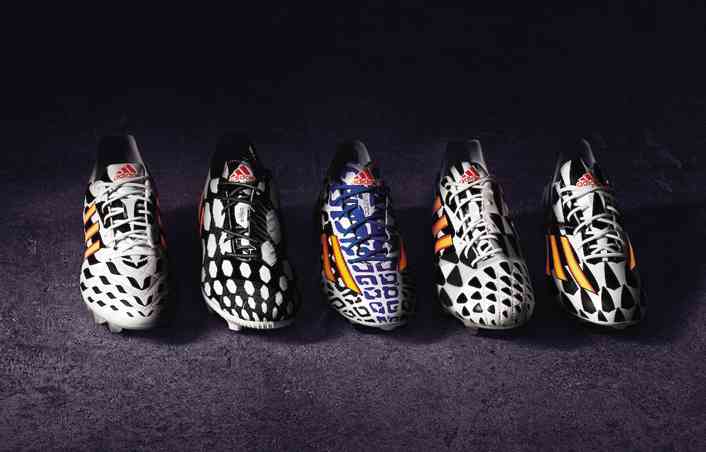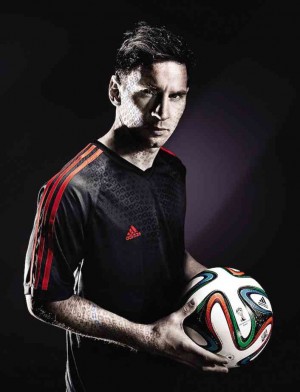World Cup fever is nearing its zenith as football superpowers Germany and Argentina prepare for their final showdown on July 13 (Monday morning in the Philippines), and Filipinos are no longer as immune as they used to be.
Football, indeed, has become more popular than ever in the Philippines, where basketball has long dominated the sports scene.
A big part of the credit goes to the ever-improving exploits of the Azkals national team on the international football scene, the establishment of the United Football League, and growing corporate support behind youth programs to encourage more Filipinos to learn the beautiful game.
Giant global sport brands adidas and Nike are feeling that increased popularity at the cash registers as more Filipinos are snapping up clothes, shoes and other sports items related to the Fifa World Cup, the world’s single largest sporting event.
According to Herman Seet, adidas regional market category manager for football, it was really just a matter of time before football started playing a bigger part in the consumption of sports fare in the Philippines given the global popularity of football and the fact that Filipinos are “connected, knowledgeable and sophisticated when it comes to sports.”
Jason Gervasio, adidas Philippines sports marketing manager, adds in an interview that for the 2014 edition of the quadrennial event, there has been significant growth in the sale of Battle Pack Football boots, the official 2014 Fifa World Cup match ball called the Brazuca and kits of favorite teams, especially that of finalist Germany, where adidas is based.
“So far, the performance of the World Cup range has been above expectations and we expect the trend to continue,” says Gervasio, adding that adidas is the global leader in football and the official sports equipment sponsor of the World Cup, providing the kits of some of the tournament favorites, such as Argentina led by Lionel Messi.
Seet predicts that, with the increase in exposure, the sport is getting through the national team’s games, as well as big global events such as the World Cup.
Football, he says, should become even more popular in the coming years, and adidas looks to ride on that wave of popularity given its leadership in the category.
“Football is an important category for adidas. It defines us as a brand all over the world, consumers see us as the global leaders in football, including the Philippines,” he adds.
US-based Nike got into football later than adidas, but it has more than made up for lost time with a major presence in the World Cup, providing the kits of such countries as Brazil, host of the event and five-time World Cup winner.
Nike Philippines country manager Courtney Cole-Faso says that since 1994, Nike has built a $2-billion global business in football through innovative products, understanding of the players’ needs, athlete and team partnerships, and consumer connections.
Among its most popular football items is the Mercurial Superfly, the latest in a series of boot innovations released in the run-up to the month-long World Cup finals.
“We’re seeing incredible sales and player reaction to all our boot silos: Magista, which we launched recently with Spain’s Andres Iniesta; the Hypervenom boot we launched with Brazil’s Neymar last summer, and the revamped Tiempo line this year (includes both on-pitch and off-pitch models). We’re confident Mercurial will have the same results,” says Cole-Faso.
Nike declined to provide definite growth and sales figures, but Cole-Faso says the World Cup certainly added “an extra boost” to the top line.
“We see the energy created by World Cup as a key driver for our brand and business,” says Cole-Faso.
Nike, after all, supported 10 teams in the 2014 World Cup finals—Brazil, England, France, Portugal, Netherlands, Greece, Croatia, the United States, Australia and South Korea. Over half of the boots worn on the pitch bore the trademark swoosh of Nike, which continues to expand its presence in the global football sector.
Meanwhile, Brazil’s hosting of the World Cup finals is helping improve the brand image of Ipanema, distributed in the Philippines by Elro Corp. led by managing director Francisco R. Elizalde.
“The emphasis and correlation of Brazil to football is the bridge to harp on Ipanema’s heritage which, in turn, increases the brand’s awareness and sales,” says Elizalde.
“Since the World Cup is happening in Brazil now, the rich culture of Brazil is now being exposed to more people, which is beneficial for us.”
Ipanema’s partnership with Balls Channel for the airing of the World Cup games likewise contributed to raising the profile of Ipanema, one of the leading footwear brands from Brazil.
“Our brand’s participation as a sponsor of the broadcast of the World Cup has definitely reaped some rewards in terms of sales. There is an ongoing advertising campaign in Balls Channel, which we feel has exposed the brand further in the market,” says Elizalde.
As for football, for which Brazil is known the world over, Elizalde sees only further growth and increased popularity, even in basketball-crazy Philippines.
“I think that the future of football in the Philippines is ripe and ready for expansion as it has in the rest of the world,” says Elizalde.
“The popularity of football on the world stage is more prevalent, and sports brands are spending large sums of money to reach out to countries like ours. We are a hot spot in the continued growth of brands like Nike and adidas. It’s in their best interest to push the sports’ popularity and help in the growth of the sport in the Philippines,” he adds.
The Philippines’ participation in the World Cup finals may not happen anytime soon, but it does not mean that Filipinos can’t join in the fun that only the Fifa World Cup finals can bring.



